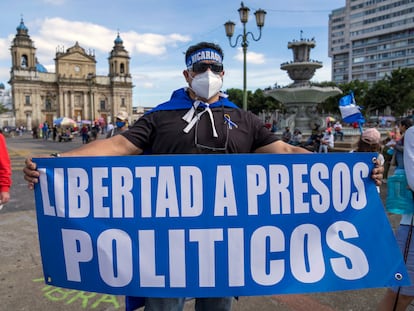Dora María Téllez and her 605 nights of hell: ‘Every day that I didn’t hang myself was a victory over Ortega’
The legendary guerilla commander from the days of Nicaragua’s Sandinista Revolution spoke to EL PAÍS about her time as a political prisoner in Managua’s feared El Chipote jail

In the 1970s, Dora María Téllez – known as “Comandante Dos” (Commander Two) of the Sandinista Revolution in Nicaragua – became known as a legendary guerilla fighter. But over the past couple of years, she was subjected to imprisonment and psychological torture by the regime of Daniel Ortega – her former comrade, now the president of Nicaragua.
During her 20 months in the feared El Chipote prison in the capital of Managua, María Téllez was prohibited from knowing the time of day. So, she devised a system: she kept her head close to one of the walls of her cell (number one) and looked up. From one of the most infamous correctional facilities in Latin America, she tried to decipher the secrets of the “completely dim” natural light “which didn’t allow her to see her own hand clearly.”
A bit of sunlight slipped through the only vent in the 250-square-foot cell. “Now it must be 11,” she would say. “It’s almost time for the bathroom.”
This was the only way for her to order the endless days. That is, until another prisoner arrived: Álex Hernández. He would spend 500 days in El Chipote.
“The kid was a genius when it came to precise time,” she remembers. From his cell – number four – he could calculate “how the sunlight entered the little corridor.”
“I whispered to him: ‘Alex, what time is it?’ He answered: ‘10.15am.’”
Téllez recalls all of this during her interview with EL PAÍS on Friday, February 10. “One day, one of the guards – who were forbidden to wear watches, so as not to give us clues – went to the bathroom, took out his own and, on the sly, confirmed it to me: ‘I don’t know how he does it: it’s 10.15!’”
María Téllez also wants to be precise about the 605 days she spent in hell. She takes a notebook and a pen, drawing a map of the place where she spent her captivity.
“The cell was 25 feet high, with a concrete ceiling,” she explains. She sits with an elegant demeanor – one that only resistance can provide – in the lobby of a hotel near Dulles International Airport. This is where, as of February 9, the US State Department has been housing 222 Nicaraguan political prisoners. They were released by the regime of President Daniel Ortega and his wife – Vice President Rosario Murillo – and subsequently placed on a chartered plane and deported to Washington, D.C..
A few hours later, as they soared through the skies to freedom, the latest retaliation came: Nicaragua’s National Assembly altered the Constitution and stripped the exiles of their Nicaraguan citizenship.
Among the group of exiles, there are journalists, politicians, businessmen, students and subsistence farmers. But the most symbolic is surely María Téllez.
“The worst of all were the afternoons in El Chipote. Very tough,” the ex-guerrilla continues. In the mornings, they were taken out of their cells to exercise, for three hours each day.“ Strengthening quadriceps, basic karate routines….” Every day, she walked five miles in circles. “80 laps,” she sighs, as she draws another diagram. It became such an obsession that she ended up injuring her foot.

This was the only possible distraction. A historian by profession – “a reader out of vital necessity” – she was forbidden from reading or writing. No books, papers or pencils were allowed.
“We slept on a smooth mat, with no cover, on the cold floor. They didn’t give us towels – we dried ourselves with our clothes.”
“There was constant psychological torture. I was never physically tortured: the treatment by the prison workers was friendly and efficient. It’s the treatment of the Ortega-Murillo regime that’s inhumane. I did the math: out of 1,440 minutes a day or so, I would only speak for a minute, if you add up all the brief exchanges with the guards. I ended up losing my voice, so I made an effort to sing softly to counter that loss.”
The lack of visitation was “another form of torture. At the start, I spent three months without seeing anyone, not even my lawyer. Then, [I had a visitor] every two months, one month, 40 days… the way they organized [the visits] was very erratic.”
Needless to say, all these prison measures are prohibited by international human rights conventions.
“The most terrible thing was the isolation. The women who were in El Chipote were all isolated. The men were never kept like this for more than two months.” When asked why this different treatment was imposed, she makes the mute gesture of firing a gun. “That’s the visceral hatred that the Ortega-Murillo family has against women.”
María Telléz gained worldwide fame when Gabriel García Márquez immortalized her in his chronicle Assault on the Palace (1978), about the legendary act of resistance to the Somoza dictatorship in 1978. The discipline she acquired in her years as a guerilla helped her face captivity. She approached it with a mentality of “everyday resistance.”
“I knew that I had to hold on – it was my way of defeating Ortega every day. Every day that I didn’t get mentally hurt, every day that I didn’t defecate in the cell. That I didn’t hang myself. Every time I had interviews and interrogations, I spoke to the officials clearly and bluntly, [knowing that] this was designed to kill us mentally and emotionally. ‘And what do you want?’ I would ask them. They wanted me to hang myself from the bars.”
She lists the effects that solitary confinement can have, based on her experience: “Anxiety disorders, profound sleep disorders (although I fall asleep at ease), defecation disorders, eating disorders, skin diseases, migraines, pigmentation problems, tooth loss, loss of vision, loss of balance. Now I have to be careful: if I move the wrong way, I could end up on the ground.”
One of the worst moments of her captivity came on the night that her former comrade-in-arms – Commander One, retired General Hugo Torres – had a relapse in cell number six, at the opposite end of the corridor.
“I heard the noise and I peeked through the bars: I saw some officers moving,” she recalls. “Someone was running. They opened the cell and a somewhat corpulent, young officer came out carrying Hugo. I realized that he hadn’t fainted – this was something else. His left arm was lifeless…”
After a while, they returned Torres to his cell. But they didn’t provide him with necessary medical attention in El Chipote. He relapsed again and was taken to a hospital, where he died. That, says María Téllez, was a tremendous blow.
This past Wednesday, when they told her to hurry up and take off her blue prison uniform, at first she thought that perhaps they were preparing her for an interview. Then, as the hours passed, she began to suspect something else.
“By then I had already ruled out the rest of the reasons. [I knew] they were kicking us out of the country. I didn’t know if [we were going to be sent] to Mexico, Colombia, or the United States.”
In Washington, she was finally able to reunite with her partner, who was also serving a sentence.
“The day of the arrest, I laughed a little when I saw [the police] enter. They came with AKs [AK-47 assault rifles], bulletproof vests… they opened doors in combat positions. There we were, quietly waiting for them, with our puppies. It was all a fantasy: the fantasy of those who are afraid. An agent pushed me, but they didn’t use more violence.”
Now in the United States, she says that she plans to continue the fight.
“Ortega thought he was going to break us, but there was not a single prisoner who asked for forgiveness. We all resisted. It’s time to reorganize and keep fighting. I’m going to return to Nicaragua. I don’t know when, but I’m going to do it and recover all my freedoms. No one can take away my nationality – which I have as a birthright – for a crime I did not commit.”
For now, she is content to be able to read again. Sapiens – by Yuval Noah Hariri – was what she was planning on reading before she was imprisoned. She also has a book about “100 years of sexual diversity from a Nicaraguan historian and an American social scientist.” She also wants to dive back into 20th century history by reading works by Eric Hobsbawn, a Marxist British historian.
Literature helps María Téllez answer the question about why President Daniel Ortega has changed so much in the years since she’s known him.
“It is an analysis that they always ask me for – I’m reluctant to do it. It seems to me that it’s not even relevant. Ortega would have to be reckoned with in one of Stefan Zweig’s profoundly psychological biographies: a biography like Joseph Fouché: Portrait of a Politician by Stefan Zweig. Fouché (the Minister of Police in France under Napoleon Bonaparte) was neither of the right nor of the left. Quite the opposite. He was a man of power, essentially unscrupulous. That’s what Ortega is: an unscrupulous power animal.”
Another urgent task for María Téllez – now that she has regained her freedom – is to “recover the dawns” that she was deprived of for more than 600 days. It started this past Friday. She woke up, fearing that “it had all just been a dream.” Then, from her room in the hotel in Virginia, she marvelled at a glorious sunrise where the sky “is completely dyed orange.”
Sign up for our weekly newsletter to get more English-language news coverage from EL PAÍS USA Edition
Tu suscripción se está usando en otro dispositivo
¿Quieres añadir otro usuario a tu suscripción?
Si continúas leyendo en este dispositivo, no se podrá leer en el otro.
FlechaTu suscripción se está usando en otro dispositivo y solo puedes acceder a EL PAÍS desde un dispositivo a la vez.
Si quieres compartir tu cuenta, cambia tu suscripción a la modalidad Premium, así podrás añadir otro usuario. Cada uno accederá con su propia cuenta de email, lo que os permitirá personalizar vuestra experiencia en EL PAÍS.
¿Tienes una suscripción de empresa? Accede aquí para contratar más cuentas.
En el caso de no saber quién está usando tu cuenta, te recomendamos cambiar tu contraseña aquí.
Si decides continuar compartiendo tu cuenta, este mensaje se mostrará en tu dispositivo y en el de la otra persona que está usando tu cuenta de forma indefinida, afectando a tu experiencia de lectura. Puedes consultar aquí los términos y condiciones de la suscripción digital.
More information

